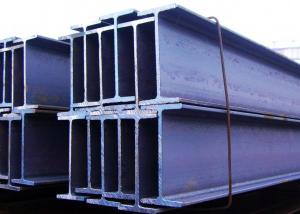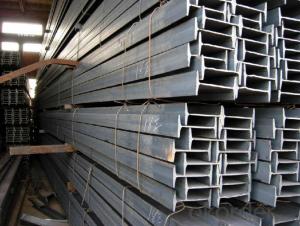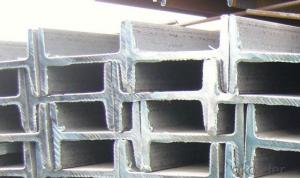I-Beam Steel
- Loading Port:
- Tianjin Port, China
- Payment Terms:
- TT or LC
- Min Order Qty:
- 25MT m.t.
- Supply Capability:
- 10000MT m.t./month
OKorder Service Pledge
OKorder Financial Service
You Might Also Like
Specifications of I-Beam Steel
Product name: I-Beam Steel
Production Standard: GB, BS, ASTM, EN, DIN, JIS
Grade: Q235B, Q345B, ASTM A36, SS400, S235JR, S275JR
Chemical composition
|
Alloy No. |
Grade |
C |
Mn |
S |
P |
Si |
|
Q235 |
B |
0.12%-0.20% |
0.3%-0.7% |
<=0.045% |
<=0.045% |
<=0.3% |
Length: 5.8M, 6M, 8M, 9M, 10M, 12M or as the requirements of the buyer
Sizes: 80MM-270MM
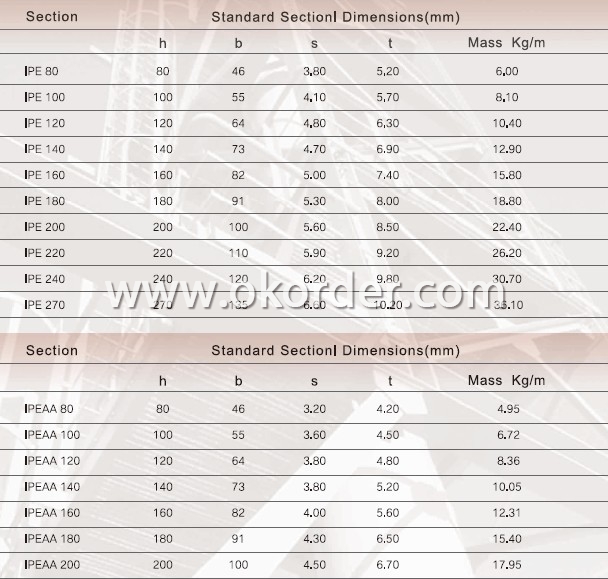
Applications of I-Beam Steel
Widely used in various building structures and engineering structures such as roof beams, bridges, transmission towers, hoisting machinery and transport machinery, ships, industrial furnaces, reaction tower, container frame and warehouse etc.
Package and Delivery
1. Package: All the products will be tired by wire rod in bundles and then put into containers 20', 40' or in bulk cargo.
Or according the requirements of the customers. Each bundle will be hung a CNBM label, which will include the information of our trademark, size, material, lengh, standard, etc. Normally, each bundle contain 50 pieces.
Bundle weight: not more than 3.5MT for bulk vessel; less than 3 MT for container load
But we can also make the bundles as the requriement of you.
2. Delivery: Within 45 days after getting the L/C ORIGINAL or the advance payment by T/T.

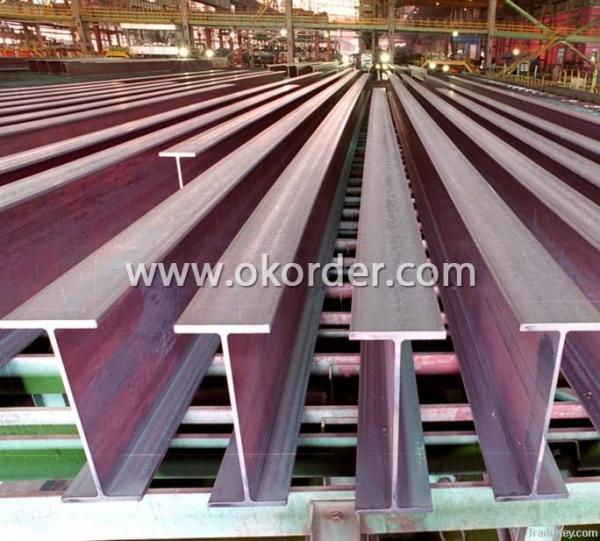
Production flow of I-Beam Steel
Material prepare (billet) —heat up—rough rolling—precision rolling—cooling—packing—storage and transportation
- Q:What are the common challenges in erecting steel I-beams on-site?
- There are several common challenges that can arise when erecting steel I-beams on-site. One of the main challenges is ensuring proper alignment and positioning of the beams. Due to their size and weight, I-beams can be difficult to maneuver and lift into place. Precise measurements and careful planning are necessary to ensure that the beams are aligned correctly and fit securely. Another challenge is the need for specialized equipment and skilled labor. Erecting steel I-beams often requires the use of cranes, hoists, and other heavy machinery. These tools must be operated by trained professionals who understand the specific requirements and safety protocols associated with working with steel beams. Lack of access to such equipment and skilled labor can pose a significant challenge during the erection process. Additionally, the weight of steel I-beams can pose challenges during transportation and installation. These beams are typically quite heavy, requiring careful coordination and planning to ensure that the site is adequately prepared to handle the weight. The need for proper safety precautions, such as securing the beams and ensuring proper bracing, adds to the complexity of the process. Furthermore, weather conditions can also present challenges during the erection of steel I-beams. High winds, rain, or extreme temperatures can impact the stability of the beams and compromise the safety of the workers involved. It is crucial to monitor weather conditions closely and take appropriate measures to mitigate any potential risks. Finally, coordination and communication among various stakeholders involved in the construction project can be a challenge. Erecting steel I-beams often requires collaboration between architects, engineers, contractors, and subcontractors. Effective communication and coordination between these parties are essential to ensure that the beams are installed correctly and meet the project's requirements. Overall, the challenges in erecting steel I-beams on-site can include alignment and positioning, the need for specialized equipment and skilled labor, the weight of the beams, weather conditions, and coordination among project stakeholders. Addressing these challenges requires careful planning, expertise, and effective communication to ensure a successful and safe installation process.
- Q:What are the typical installation methods for steel I-beams?
- The installation methods for steel I-beams typically vary depending on the specific project requirements and the structural design. However, there are several common installation methods that are frequently utilized. One common method is the use of a crane or other heavy lifting equipment to hoist and position the steel I-beams into place. This method is often employed when dealing with large and heavy beams that require precise placement. The crane is used to lift the beam and carefully maneuver it into the desired location, ensuring that it is aligned correctly and securely fastened. Another method involves the use of a gantry system, which consists of a series of movable supports on rails. The gantry system can be used to lift and move the steel I-beams horizontally and vertically, allowing for controlled placement and alignment. This method is often used in construction projects where the beams need to be lifted and positioned at various heights and angles. In some cases, steel I-beams may be installed using a combination of manual labor and mechanical assistance. This method may involve using a team of workers to guide and position the beams while using machinery, such as forklifts or skid steers, to provide additional support and lifting power. This method is often employed when dealing with smaller or lighter beams that can be easily maneuvered by hand or with minimal mechanical assistance. Furthermore, it is important to note that the installation of steel I-beams typically requires the expertise of professionals, such as structural engineers or construction contractors, who have the knowledge and experience to ensure proper installation and adherence to safety standards. Additionally, the installation process may involve the use of specialized tools and equipment, such as welding machines or bolt fasteners, to secure the beams in place. Overall, the installation methods for steel I-beams can vary depending on the specific project requirements, but they generally involve the use of cranes, gantry systems, manual labor, and mechanical assistance to hoist, position, and secure the beams into place.
- Q:Can steel I-beams be used in airport terminals?
- Yes, steel I-beams can be used in airport terminals. Steel I-beams are commonly used in the construction industry for their strength, durability, and versatility. They provide structural support and are often used to create the framework for large, open spaces such as airport terminals. The high load-bearing capacity of steel I-beams allows for the creation of large spans and open floor plans, which are essential in airport terminals to accommodate large crowds and provide flexibility for various facilities such as check-in counters, security areas, lounges, and retail spaces. Additionally, steel I-beams can withstand extreme weather conditions and offer fire-resistant properties, making them a suitable choice for airport terminals that prioritize safety and security.
- Q:Can steel I-beams be used for industrial platforms or catwalks?
- Absolutely, industrial platforms or catwalks can indeed utilize steel I-beams. Renowned for their robustness and resilience, steel I-beams present an exceptional option for such purposes. Their capacity to uphold substantial weights and endure continuous pedestrian movement, alongside other industrial operations commonly observed on platforms or catwalks, further solidifies their suitability. Moreover, steel I-beams offer the advantage of effortless customization to meet precise design and structural prerequisites, thereby facilitating efficient and secure construction of industrial platforms or catwalks.
- Q:Shear strength of No. 16 I-beam
- Is the index of material strength, mechanical strength, mechanical properties of steel I-beam is divided, tensile strength, compressive strength, flexural strength, shear strength and end bearing strength, due to material and thickness and different grades.
- Q:How do steel I-beams perform in terms of wind resistance?
- I-beams made of steel have a reputation for their exceptional performance when it comes to resisting wind. The structural design of the I-beam, featuring flanges and webs, provides incredible strength and rigidity, making it highly resistant to the forces exerted by wind. The shape of the I-beam allows for the efficient distribution of the wind load, minimizing the possibility of failure or damage. The flanges of the I-beam are specifically crafted to withstand bending and torsional forces caused by wind, while the web helps maintain the overall stability and stiffness of the beam. This combination of design elements ensures that the I-beam can endure high wind speeds and turbulent conditions. Furthermore, steel itself is an extremely durable and robust material, which further enhances the wind resistance of I-beams. Steel possesses a high tensile strength and elasticity, enabling it to effectively absorb and distribute the wind load. Additionally, steel is not prone to rot, warping, or decay, unlike certain other building materials, guaranteeing long-lasting durability and performance even in harsh weather conditions. All in all, steel I-beams are widely acknowledged as one of the most dependable and efficient choices for withstanding wind forces. Their structural design, coupled with the strength and durability of steel, make them the preferred option in construction projects that require sturdy wind resistance.
- Q:Can steel I-beams be used in stadiums or arenas?
- Steel I-beams are indeed suitable for use in stadiums or arenas. These large structures often utilize steel I-beams in their construction because of their impressive strength, durability, and versatility. With their ability to bear heavy loads, steel I-beams are perfect for the expansive areas found in stadiums and arenas. They provide essential structural stability and can withstand the dynamic forces exerted by substantial crowds, equipment, and sporting events. Moreover, steel I-beams offer the advantage of design flexibility, enabling architects and engineers to construct distinctive and visually captivating edifices. Ultimately, the exceptional structural properties and ability to meet the rigorous demands of these vast facilities make steel I-beams a highly favored option for stadiums and arenas.
- Q:Can steel I-beams be used for aircraft hangars?
- Indeed, aircraft hangars can utilize steel I-beams. These beams find widespread use in construction owing to their robustness and endurance, rendering them an excellent choice for upholding the weight of aircraft hangar structures. Withstanding substantial loads and offering stability are essential attributes for colossal structures such as aircraft hangars, which steel I-beams readily provide. Moreover, these beams can be customized to precise measurements and lengths, accommodating the specifications of the hangar design, affirming their versatility in construction endeavors.
- Q:Can Steel I-Beams be used for educational institutions like schools or universities?
- Yes, Steel I-Beams can be used for educational institutions like schools or universities. Steel I-Beams are commonly used in construction due to their structural strength and durability. They provide a stable framework for large buildings, making them suitable for educational institutions that require spacious and long-lasting structures. Additionally, steel I-beams can support heavy loads, making them ideal for constructing multi-story buildings or auditoriums within educational campuses.
- Q:Can steel I-beams be used in interior design or decorative applications?
- Yes, steel I-beams can be used in interior design or decorative applications. They are often utilized to create a modern and industrial look in residential and commercial spaces. The clean lines and structural strength of steel I-beams can add a unique and contemporary aesthetic to various interior design elements such as exposed ceilings, staircase supports, mezzanines, room dividers, and shelving systems.
1. Manufacturer Overview |
|
|---|---|
| Location | Qinhuangdao, China |
| Year Established | 2000 |
| Annual Output Value | Above US$ 300 Million |
| Main Markets | Mid East; Africa; Southeast Asia; Brazil |
| Company Certifications | ISO 9001:2008; |
2. Manufacturer Certificates |
|
|---|---|
| a) Certification Name | |
| Range | |
| Reference | |
| Validity Period | |
3. Manufacturer Capability |
|
|---|---|
| a)Trade Capacity | |
| Nearest Port | Tianjin; |
| Export Percentage | 70% - 80% |
| No.of Employees in Trade Department | 21-50 People |
| Language Spoken: | English; Chinese; |
| b)Factory Information | |
| Factory Size: | Above 400,000 square meters |
| No. of Production Lines | 2 |
| Contract Manufacturing | OEM Service Offered; |
| Product Price Range | Average |
Send your message to us
I-Beam Steel
- Loading Port:
- Tianjin Port, China
- Payment Terms:
- TT or LC
- Min Order Qty:
- 25MT m.t.
- Supply Capability:
- 10000MT m.t./month
OKorder Service Pledge
OKorder Financial Service
Similar products
New products
Hot products
Hot Searches
Related keywords
